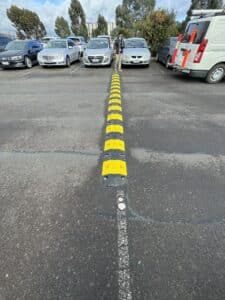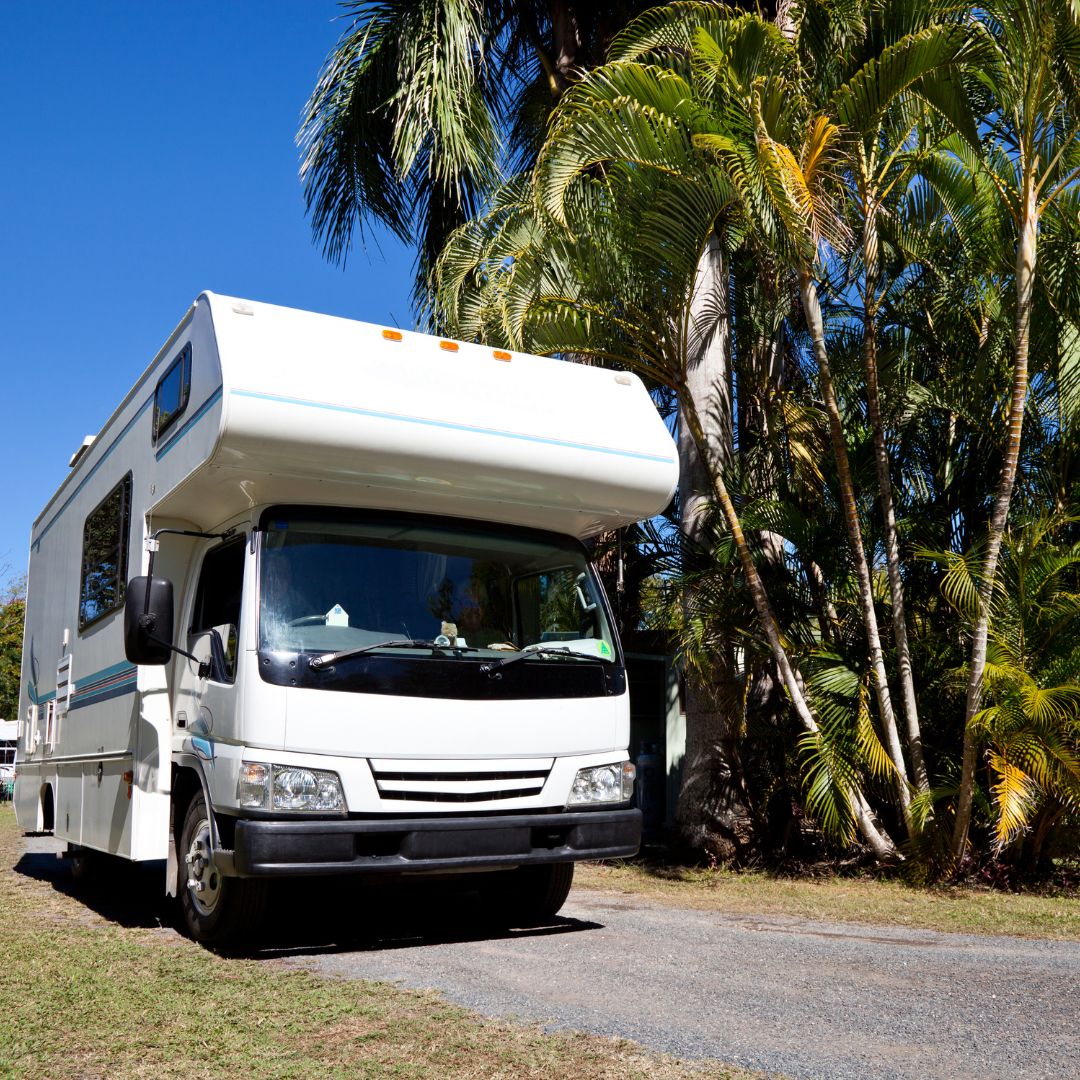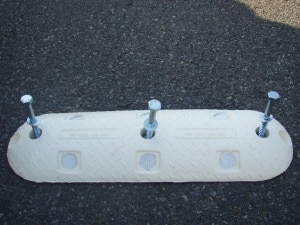

With the increasing popularity of Caravan Parks, there are potential safety challenges that we need to be aware of. Ensuring pedestrian safety and minimizing the risks associated with shared spaces between pedestrians and vehicles is paramount. This article explores the potential hazards in caravan park settings, suggests strategies for reducing vehicle speeds, and increasing pedestrian awareness, and proposes the installation of speed humps, pedestrian crossings, and clear signage to enhance safety.
As pedestrians and vehicles are in close proximity within these spaces this presents a unique set of challenges, including limited visibility, diverse user behaviours, and potential distractions. It’s imperative to implement effective strategies that mitigate these risks and create a safer environment.
Possible solutions include the strategic installation of high-quality speed humps, well-marked pedestrian crossings, and highly visible signage. These measures not only serve to reduce vehicle speeds but also promote a culture of mutual respect and safety, ensuring that both pedestrians and drivers can navigate shared spaces safely, with confidence and peace of mind.
Limited Visibility: Caravan parks often encompass a diverse range of terrains, including winding pathways, greenery, and uneven surfaces. While these elements contribute to the park’s appeal, they can also limit visibility for both pedestrians and drivers. Corners, vegetation, and changes in elevation can obscure sightlines, increasing the risk of collisions between pedestrians and vehicles.
Diverse User Behaviors: Caravan parks are magnets for people of all ages, from children and families to seniors and individuals with varying mobility levels. This diversity translates into a wide range of user behaviours. Pedestrians may be walking, jogging, pushing strollers, or using mobility aids, while drivers might be navigating slowly or searching for parking. These differences in behaviour can create unpredictable scenarios, demanding heightened awareness from all parties involved.
Potential Distractions: The allure of caravan parks lies not only in their natural beauty but also in the recreational activities they offer. This can lead to potential distractions for both pedestrians and drivers. Pedestrians might be engrossed in conversations, taking photographs, or enjoying their surroundings, while drivers could be distracted by the park’s ambience or looking for available parking spaces. These distractions divert attention away from potential hazards and increase the likelihood of accidents.
To ensure the safety of all users within caravan parks, it’s imperative to address the hazards associated with pedestrian-vehicle interaction:
Enhanced Signage: Clear and strategically placed signage can inform both pedestrians and drivers of potential hazards and designated crossing zones. Signage should highlight the presence of pedestrians, indicate speed limits, and offer directions to parking areas. Illuminated signs can be particularly effective during low-light conditions.
Pedestrian-Focused Infrastructure: Designated pathways for pedestrians and well-marked crossings should be established to guide pedestrians safely across vehicle routes. Implementing dedicated pedestrian zones helps minimize the potential for conflicts between pedestrians and vehicles.
Educational Initiatives: Educational campaigns can raise awareness among both pedestrians and drivers about the need for vigilance and cooperation in shared spaces. Informative materials can outline safe behaviours, such as looking both ways before crossing and obeying speed limits.
Surveillance and Monitoring: Utilizing technology like security cameras and mirrors at blind corners can enhance visibility and provide real-time insights into potential risks. These tools empower both pedestrians and drivers to make informed decisions based on real-time conditions.
Speed Reduction Measures: Installing speed humps can play a crucial role in reducing vehicle speeds within caravan parks. Speed humps compel drivers to slow down, offering pedestrians more time to cross and react to potential hazards.
The intricate interplay between pedestrians and vehicles in caravan park settings demands comprehensive safety measures. By addressing the unique challenges posed by limited visibility, diverse user behaviours, and potential distractions, we can create environments that prioritize the safety of all individuals.
Within caravan park settings, the balance between pedestrians and vehicles is crucial, necessitating a keen emphasis on reducing vehicle speeds.
The essence of road safety lies in maintaining controlled speeds that allow drivers to react to unexpected situations while providing pedestrians ample time to cross safely. Caravan park environments, bustling with varying activities and people of all ages, demand reduced vehicle speeds to prevent collisions, creating a secure atmosphere. Speed reduction serves as a proactive measure to avert potential hazards, ensuring that both pedestrians and drivers can navigate the shared space without fear or risk.
Traffic calming measures are instrumental in achieving speed reduction goals. These measures encompass a range of strategies designed to slow down vehicles, encourage safe driving behaviour, and enhance overall road safety. Within caravan parks, where pedestrian safety is paramount, implementing effective traffic calming measures becomes imperative.
Speed Humps: Speed humps are raised platforms placed strategically along roadways to force drivers to slow down. They are particularly effective due to the abrupt change in elevation, prompting drivers to navigate cautiously.
Speed Cushions: Speed cushions are variations of speed humps with spaces in between to accommodate larger vehicles like emergency vehicles and buses. They offer effective speed reduction while allowing specific vehicles to pass smoothly.
Chicanes: Chicanes are geometric changes in the road layout, often in the form of zig-zag patterns. They create a winding path that requires slower speeds, enhancing safety while adding visual interest to the road.
Speed humps, in particular, offer several advantages that contribute to effective speed reduction without compromising driver comfort:
Gradual Profile: Well-designed speed humps have a gradual incline and decline, ensuring a smoother transition for vehicles. This minimizes discomfort for drivers while successfully slowing them down.
Controlled Speeds: Speed humps are strategically placed to encourage drivers to adhere to reduced speeds. They provide a physical reminder of the need to slow down, contributing to a safer environment for pedestrians and vehicles.
Visibility: Clearly marked speed humps are visible to drivers, giving them ample time to prepare for the change in road conditions. This visibility further reinforces the importance of controlled speeds.
Cost-Effectiveness: Speed humps are cost-effective solutions for speed reduction. They require relatively simple installation and maintenance procedures while offering substantial safety benefits.
Traffic calming measures, including well-designed speed humps, speed cushions, and chicanes, play a pivotal role in achieving this objective. These measures not only contribute to speed reduction but also foster an atmosphere of shared responsibility, where drivers prioritize pedestrian safety.
Traffic safety in caravan parks and prioritizing pedestrian awareness are paramount. We must create spaces where pedestrians and drivers coexist harmoniously, reducing the risk of collisions and fostering a safer atmosphere.
Elevating pedestrian awareness is pivotal in preventing collisions and promoting a culture of safety. By Increasing awareness, individuals can anticipate and react to potential hazards effectively, reducing the chances of accidents. This proactive approach not only safeguards pedestrians but also encourages responsible driving behaviour, creating an environment of mutual respect and shared responsibility.
Designated pedestrian zones play an important role in protecting the safety of pedestrians. These zones clearly separate pedestrian pathways from automobile routes, reducing the possibility of conflicts. Caravan parks can establish spaces for pedestrians to walk without the continual worry of automotive traffic by separating these two forms of transportation. Designated zones emphasise pedestrians’ right of way, emphasising their safety and contributing to a secure environment.
Educational initiatives are effective instruments for teaching safe behaviours to both pedestrians and drivers. These programmes are critical in raising awareness about the potential hazards in caravan parks and the activities people can take to mitigate such hazards. Informative items, such as brochures, posters, and digital information, can teach pedestrians the value of utilising marked crossings and looking both ways before crossing. The campaigns emphasise the importance of slowing down, being attentive, and ceding pedestrians for vehicles.
Pedestrian Safety Promotion: Educational initiatives urge pedestrians to use designated routes, crosswalks, and pedestrian-only zones. They emphasise the significance of making eye contact with vehicles, using crosswalks, and remaining attentive to their surroundings.
Drivers are trained on the importance of obeying speed restrictions within caravan parks, maintaining awareness for pedestrians, and surrendering the right of way at crosswalks. The commercials also emphasise the necessity of avoiding distractions while driving.
The combination of enhanced pedestrian awareness, designated pedestrian zones, and educational campaigns creates a multi-pronged approach to safety within caravan parks. By fostering a collective understanding of shared responsibilities, both pedestrians and drivers contribute to the creation of an environment where collisions are minimized, and safety is prioritized.
Increasing pedestrian awareness in caravan parks is a pivotal step towards reducing collisions and creating a secure environment. The combination of designated pedestrian zones and educational campaigns empowers both pedestrians and drivers to play an active role in preventing accidents.
Signage is also very important in conveying rules, speed limits, and pedestrian crossings, and its impact on reducing confusion, we can create environments that prioritize safety and enhance overall well-being.
Clear signage acts as a virtual guide, providing essential information to both pedestrians and drivers. In the context of caravan parks, where the mix of activities and varying user behaviours can be overwhelming, well-placed signs serve as silent communicators. They indicate designated pathways, vehicle-free zones, pedestrian crossings, and critical rules, ensuring that individuals can navigate the space with confidence and awareness.
Visible signage provides effective communication within caravan parks. Signs that are easily seen and understood by all age groups and language backgrounds contribute to a sense of order and safety. These signs convey crucial information such as speed limits, yielding to pedestrians, and directions to parking areas. Visible signage ensures that everyone within the park is aware of the rules and regulations, reducing the potential for accidents and misunderstandings.
Signage plays a vital role in conveying rules and speed limits. Speed limit signs help drivers adhere to safe speeds, preventing accidents caused by excessive speed. Pedestrians are informed of crossing points and pedestrian-only areas through clear and concise signage. By establishing rules through signage, both pedestrians and drivers are empowered to make informed decisions that prioritize safety.
The design of signage can significantly impact overall safety. Well-designed signs, using universally recognizable symbols and clear language, reduce the potential for confusion. A consistent design aesthetic creates a visual identity that helps pedestrians and drivers quickly identify critical information. This consistency minimizes cognitive load, allowing individuals to focus on their surroundings and make safe choices.
Minimized Ambiguity: Clear signage leaves no room for interpretation, ensuring that individuals understand rules and directions without confusion.
Enhanced Predictability: Well-designed signs make it easier for pedestrians and drivers to predict each other’s actions, leading to smoother interactions and fewer surprises.
Informed Decision-Making: Access to clear information empowers individuals to make informed decisions, reducing the likelihood of accidents caused by uncertainty.
In caravan parks, the power of clear signage extends beyond information provision. It creates an atmosphere of predictability, respect, and shared responsibility. Signs guide pedestrians and drivers to coexist harmoniously, reducing conflicts and fostering a sense of community safety.
Clear signage is a critical component of caravan park safety practices. It acts as a visual guide, transmitting regulations, speed limits, and directions to help walkers and automobiles traverse shared spaces safely.
Pedestrian crossings are critical in providing safe spaces for pedestrians to cross. The importance of clearly designated and well-lit crossings inside trailer parks cannot be overstated. Crosswalks that are properly marked improve pedestrian safety and create conditions that enable people to navigate shared places with confidence and security.
These crossings function as designated pathways for pedestrians to safely cross roadways. Pedestrian crossings are essential in caravan parks, where people of all ages participate in a variety of activities. They allow people to travel from one side of the road to the other without worry of being hit. These markings inform drivers that pedestrians have the right of way, emphasising their safety and establishing a conducive atmosphere for cooperation.
Pedestrian crossings that are well-marked and well-lit are especially important in caravan parks, where activities may linger into the late hours. These marks are intended to capture the attention of both pedestrians and automobiles, making the crossing places extremely visible and lowering the possibility of accidents. Adequate illumination ensures that crosswalks are plainly visible even in low-light settings, further improving pedestrian safety.
Properly designated crossings contribute substantially to pedestrian safety in caravan parks:
Visual Cues for Pedestrians and Drivers: Well-marked pedestrian crossings provide strong visual cues to pedestrians, leading them to safe crossing spots. These markers act as reminders to automobiles to yield to pedestrians, establishing a culture of mutual respect and safety.
Reduced Conflicts: Properly marked crossings provide order within the shared space. Pedestrians and drivers are more likely to anticipate each other’s activities, reducing conflicts and potential collisions.
Pedestrian trust: Clearly designated pedestrian crossings generate trust in pedestrians, allowing them to cross with the knowledge that drivers are aware of their presence and would yield accordingly.
Increased Accessibility: Well-designed pedestrian crossings reflect the requirements of all pedestrians, including those with mobility issues. Markings can contain characteristics such as tactile indicators, ensuring a safe crossing experience for everybody.
Consistency in Behaviour: Properly marked crossings encourage consistent behaviour from both pedestrians and automobiles. Pedestrians know where to cross, and cars are reminded of their obligation to yield.
Effectively marked pedestrian crossings are a vital component of maintaining a safe environment within caravan parks. They send the message that pedestrian safety is a top priority and encourage appropriate behaviour from both walkers and drivers.
The significance of clearly designated pedestrian crossings in caravan parks cannot be emphasised. These markings provide specified safe crossing points for pedestrians and serve as visible reminders for automobiles to yield.
Each caravan park presents its own set of challenges and dynamics. To address these variations, customized solutions that align with the specific requirements of each park are needed. This involves collaborating closely with park management to assess the layout, traffic flow, and pedestrian patterns. This approach ensures that solutions are not only effective but also seamlessly integrated into the park’s environment.
Lowering Vehicle Speeds: Speed humps are intentionally placed to naturally slow vehicles, so creating an atmosphere in which drivers adhere to safe speeds. This slower speed allows pedestrians more time to cross streets and react to any threats.
Increased Pedestrian Awareness: Speed humps urge both pedestrians and cars to be more attentive and aware of their surroundings. Drivers are more likely to yield to pedestrians when they cross at designated sites, while pedestrians are more inclined to cross at designated points.
Creating Safe Zones: Speed humps help to create designated pedestrian zones by urging vehicles to slow down in high-traffic areas. This separation between pedestrians and vehicles reduces the possibility of conflicts.
Reduce Distractions: Speed humps lessen the impact of distractions by requiring drivers to slow down, allowing both drivers and pedestrians to focus on their respective activities.
Spreading the Word About Shared Accountability: The presence of well-designed speed humps conveys the message of shared accountability. Drivers and pedestrians are advised to prioritise safety and respect each other’s presence.
Speed humps that are flexible in design help to safer pedestrian-vehicle interactions in caravan parks. Safety needs to be at the centre of every choice by partnering with park management and adjusting solutions to the park’s particular characteristics.
It is obvious that building secure settings necessitates a multifaceted strategy. The path to pedestrian-vehicle safety in caravan parks necessitates a combination of tactics, flexible solutions, and a constant commitment to creating safe settings.
At Speed Humps Australia, we’ve spent over twenty years focusing on one thing: to provide one style of product and to do it exceptionally well. We have worked tirelessly to develop specifications that do not fade or deteriorate, are easy to install, and are made from high-quality, recycled rubber for minimal environmental impact.
With just a handful of our clients around the nation including KFC, Taco Bell, McDonald’s, Coffee Club, Westfield, Shell, Queensland Government, and numerous local councils and mining operations our rumble bars, speed humps and wheel stops have been purposefully designed to truly go the distance.
As our design and production are all handled in-house and supplied Australia-wide, get in touch with us today to request a quote or discuss how we can help with providing a tailored solution to your unique project requirements.



For 10 years, our focus has been on one thing: to provide one style of product and to do it well.
Our wheel stops, speed humps and rumble bars meet Australian Standards, don’t fade, and we’ve never needed to replace one.

For 10 years, our focus has been on one thing: to provide one style of product and to do it well.
Our wheel stops, speed humps and rumble bars meet Australian Standards, don’t fade, and we’ve never needed to replace one.